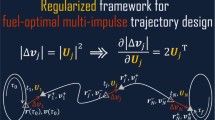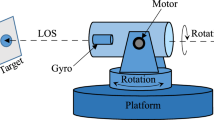Abstract
A methodology is proposed to design optimal time-fixed impulsive transfers in the vicinity of the L2 libration point of the Earth-Moon system, taking the construction of a space station around the collinear libration points as the background. The approximate analytical expression of motions around the L2 point in the CRTBP is given, and the expression in the ERTBP is derived by linearizing the dynamical equations for the purpose of expanding the methodology from the CRTBP to the ERTBP. Thus, the approximate analytical solution of the transfer between two points is obtained by substituting the position vectors of the two points into the expression, which solves the Lambert problem in the three-body system. Furthermore, the transfer between different orbits is constructed by parameterization of the position vectors with the amplitudes and phases of the initial orbit and the final orbit. The transfers are optimized such that the total velocity increment required to implement the transfer exhibits a global minimum. The values of variables involved in the optimal transfers are determined by the unconstrained minimization of a function of one or nine variables using a multivariable search technique. To numerically ensure that the transfers are accurate and to eliminate the linearization bias, the differential correction and SQP method are employed. The optimality of the transfers is determined lastly by the primer vector theory. Simulations of point-to-point transfers, Lissajous-to-Lissajous transfers, halo-to-halo transfers and Lissajous-to-halo transfers are made. The results of this study indicate that the approximate analytical solutions, as well as the differential correction and SQP method, are valid in the design of the optimal transfers around the libration points of the restricted three-body problem.











Similar content being viewed by others
References
Cao, P., He, B., Li, H.: Analysis of direct transfer trajectories from LL2 halo orbits to LLOs. Astrophys. Space Sci. 362(9), 153 (2017)
Chen, Z.: L1-optimality conditions for the circular restricted three-body problem. Celest. Mech. Dyn. Astron. 126(4), 461–481 (2016a)
Chen, Z.: Optimality conditions applied to free-time multi-burn optimal orbital transfers. J. Guid. Control Dyn. 39(11), 2512–2521 (2016b)
Davis, K.E.: Locally optimal transfer trajectories between libration point orbits using invariant manifolds. Ph.D Thesis, University of Colorado at Boulder (2009)
Gómez, G.: Dynamics and Mission Design Near Libration Points: Fundamentals-the Case of Collinear Libration Points. World Scientific, Singapore (2001)
Gómez, G., Jorba, A., Masdemont, J., et al.: Study refinement of semi-analytical halo orbit theory. In: Final Report, ESOC Contract, p. 8625/89 (1991)
Hiday-Johnston, L.A., Howell, K.C.: Impulsive time-free transfers between halo orbits. Celest. Mech. Dyn. Astron. 64(4), 281–303 (1996)
Lawden, D.F.: Optimal Trajectories for Space Navigation. Butterworths, London (1963)
Lian, Y., Tang, G.: Libration point orbit rendezvous in real Earth-Moon system using terminal sliding mode control. In: 6th International Conference on Recent Advances in Space Technologies, Istanbul, Turkey, pp. 315–319 (2013a)
Lian, Y., Tang, G.: Libration point orbit rendezvous using PWPF modulated terminal sliding mode control. Adv. Space Res. 52(12), 2156–2167 (2013b)
Lian, Y., Meng, Y., Tang, G., et al.: Constant-thrust glideslope guidance algorithm for time-fixed rendezvous in real halo orbit. Acta Astronaut. 79(79), 241–252 (2012)
Peng, H., Gao, Q., Wu, Z., et al.: Symplectic adaptive algorithm for solving nonlinear two-point boundary value problems in astrodynamics. Celest. Mech. Dyn. Astron. 110(4), 319–342 (2011)
Peng, H., Jiang, X., Chen, B.: Optimal nonlinear feedback control of spacecraft rendezvous with finite low thrust between libration orbits. Nonlinear Dyn. 76(2), 1611–1632 (2014)
Pernicka, H.J.: The numerical determination of nominal libration point trajectories and development of a station-keeping strategy. PhD Thesis, Purdue University (1990)
Qu, Q., Xu, M., Peng, K.: The cislunar low-thrust trajectories via the libration point. Astrophys. Space Sci. 362(5), 96 (2017)
Sato, Y., Kitamura, K., Shima, T.: Spacecraft rendezvous utilizing invariant manifolds for a halo orbit. Trans. Jpn. Soc. Aeronaut. Space Sci. 58(5), 261–269 (2015)
Sukhanov, A., Prado, A.F.B.A.: Lambert problem solution in the Hill model of motion. Celest. Mech. Dyn. Astron. 90(3–4), 331–354 (2004)
Sun, Y., Zhang, J., Luo, Y.: Rendezvous trajectory design of libration points based on three-body Lambert problem. Manned Spaceflight. 23(5), 608–613 (2017)
Szebehely, V.: Theory of Orbits. The Restricted Problem of Three Bodies. Academic Press, New York and London (1967)
Ulybyshev, Y.: Optimization of low thrust rendezvous trajectories in vicinity of Lunar L2 Halo orbit. In: AIAA/AAS Astrodynamics Specialist Conference, Long Beach, California, p. 5641 (2016)
Zeng, H., Zhang, J.: Design of impulsive Earth-Moon halo transfers: lunar proximity and direct options. Astrophys. Space Sci. 361(10), 328 (2016)
Zhang, P., Li, J., Baoyin, H., et al.: A low-thrust transfer between the Earth-Moon and Sun-Earth systems based on invariant manifolds. Acta Astronaut. 91, 77–88 (2013)
Acknowledgements
This work was supported by the National Key R&D Program of China (Grant No. 2018YFA0703800). The authors greatly appreciate the support. The authors would also like to thank the editor-in-chief, the associate editor and reviewers for their valuable comments and constructive suggestions that helped to improve the paper significantly.
Author information
Authors and Affiliations
Corresponding author
Additional information
Publisher’s Note
Springer Nature remains neutral with regard to jurisdictional claims in published maps and institutional affiliations.
Rights and permissions
About this article
Cite this article
Zhou, J., Hu, J., Bai, Y. et al. Optimal impulsive time-fixed transfers around the libration points of the restricted three-body problem. Astrophys Space Sci 365, 79 (2020). https://doi.org/10.1007/s10509-020-03793-7
Received:
Accepted:
Published:
DOI: https://doi.org/10.1007/s10509-020-03793-7




